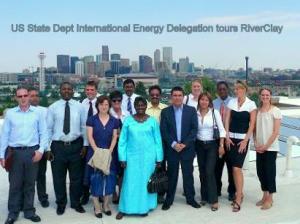
Installing solar PV at RiverClay
I was privileged to be a partner in developing the first Leadership in Energy and Environmental (LEED) certified condominium in the Rocky Mountain Region. RiverClay Condominiums was certified at the Silver level by the US Green Building Council. Sadly there continue to be many nay-sayers among traditional developers about the relative value of LEED-certification. This opinion may be formed by mis-information about relative costs and a reluctance to leave behind “business as usual.” But from a consumer standpoint it is indisputable that a third-party, rigorously-verified “green” standard gives far greater assurance about the authenticity of any claim to sustainability or higher-performance. And business as usual no longer has any place in business given the current economic conditions that those practices have led us to.

International Energy Delegation tours solar array at RiverClay
If you are a home buyer or renter and seek to live your values, don’t settle for caveat emptor. Demand, instead, “buyer be informed.”
Are there green- or energy-performance standards other than LEED? Absolutely! Are they all equally quantifiable and equally authenticated? Absolutely not!
If you are considering a “green” home, make sure you go into the transaction with a list of specific questions and concerns and don’t settle for any answer that is not verifiable by a credible source. If you are represented by a real estate agent, make sure this person has expertise with high-performance, sustainable systems. And, too, know the basics of the rubric of any performance standard cited. Some standards are based on the developer simply checking a box. Others require claims to be audited by a neutral third-party expert. Still others look to verify beyond a single point in time to historical performance, that is: has the original performance claim, in fact, been met. Don’t overlook older homes that have been improved by an energy remodel; new isn’t always better when it comes to certain aspects of construction.
As LEED and other green building standards have increasing history in the market there will be more “certified” homes to chose from. And some certifications will fall by the wayside while others aggregate a degree of market dominance. Today green-certified housing along the Colorado Front Range is relatively limited – but the good news is that its inventory is growing as consumers place higher expectations on the performance of their homes. Send me a comment if you want assistance in identifying some of these new options in the Denver metro area.
It’s been the case in the recent past that “green” costs more but as market demand increases, energy-effective performance will become not a privilege of the rich but a protocol for the populace. High-performance can no longer be a luxury for the financially endowed. Vox populi will have to be heard now that so many are struggling to make household budgets meet basic needs: we can longer afford to squander our resources.
By taking care of what we have, by demanding efficient performance, by voting our values with our dollars, by investing in our communities from our homes outward, by re-engaging values and habits of self-reliance and appreciation, we can all come again to live a “rich” life.
Where in your home, in your consumer choices, in your personal exchanges can you make what you currently have perform better and last longer? Do you know how to evaluate the efficiency of your current home and its systems? Do you know where to find high-performance standards?